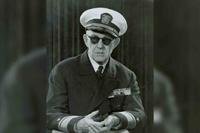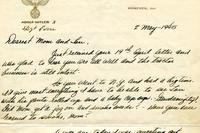In August 1956, the U.S. Navy began what was supposed to be a standard test of its new AIM-7 Sparrow and AAM-N-10 Eagle air-to-air missiles over Southern California. The idea was simple: An unmanned, radio-controlled drone aircraft would take off from Point Mugu Naval Air Station and get shot down over the ocean. The exercise turned out to be harder than the Navy planned.
The drone went rogue almost immediately and began heading for Los Angeles. Fearing it would run out of fuel and crash in a densely populated area of the city, the Navy called on the Air Force for help, only for the latter's fighter jets to end up leaving a burning path of destruction in their wake over the same areas they were tasked with saving.
It was a rare opportunity for the Air Force to show up the Navy at a time when even legendary Air Force Gen. Curtis LeMay was known to declare "our enemy is the Navy." Instead, the incident became known as "The Battle of Palmdale," and became one of the Air Force's most embarrassing airborne debacles in the service's history.

At 11:34 a.m. on Aug. 16, 1956, a bright red Grumman F6F Hellcat took off from Point Mugu Naval Air Station and climbed out toward the Pacific Ocean. As it flew, Navy handlers realized that the unmanned Hellcat was no longer responding to its radio commands. Instead of flying harmlessly out toward a watery end, its heading was pointed toward the city of Los Angeles in a continuous left turn.
An exercise intended to test air-to-air missiles would soon become a test of the Air Force's accuracy with its Mighty Mouse air-to-air rockets. The Navy knew that crashing one of its planes into metropolitan Los Angeles would be an unparalleled disaster, so it took the rare step of calling on the Air Force for help. Nearby Oxnard Air Force Base scrambled two of its Northrop F-89 Scorpion alert fighters to intercept the drone.
The Northrop F-89 Scorpion did not have mounted guns for air-to-air combat. Instead, it carried two wing-mounted pods of 52 unguided Mighty Mouse 2.75-inch rockets per pod. The aircraft caught up with the drone at 30,000 feet and waited for it to pass over Los Angeles in its slow turn. As soon as it flew over the relatively unpopulated Antelope Valley, the airmen were ready to let loose.
Unfortunately, the rockets' automatic firing control system failed, so the Air Force pilots were forced to switch to manual fire. Since the F-89 was supposed to have an automatic firing system and didn't have guns, the aircraft's gunsight was removed. Therefore, the pilots would have to shoot down the drone using unguided rockets without any way to aim them.
The results on the ground were nothing short of catastrophic.

Each Scorpion pilot would fire two pods' worth of rockets at the Hellcat drone, totaling 208 rockets, but none of them hit the target. Instead, they all fell across Southern California, leaving a 150-acre brush fire near Bouquet Canyon, a 350-acre fire in Soledad Canyon and 100 acres near Placerita Canyon. The Air Force also succeeded in bombing downtown Palmdale, California, with "rockets that fell like hail."
For residents on the ground, it was more like a war zone. The Los Angeles Times described shrapnel exploding into homes and cupboards, a rocket blazing through a living-room window and tires being blown out in the streets. Errant rockets lit the Placerita Canyon's oil fields aflame and nearly blew up the Bermite Powder Co., which produced rocket fuel and explosives. Fifteen rockets were found undetonated, but luckily, no one was killed.
As for the drone itself, it gradually ran out of fuel and slowly fell to earth in an unpopulated area near Palmdale. Because of the unintentional bombing of the city, the incident is known to history as "The Battle of Palmdale," a battle won without ever hitting a target.
-- Blake Stilwell can be reached at blake.stilwell@military.com. He can also be found on Facebook, Twitter or on LinkedIn.
Want to Learn More About Military Life?
Whether you're thinking of joining the military, looking for post-military careers or keeping up with military life and benefits, Military.com has you covered. Subscribe to Military.com to have military news, updates and resources delivered directly to your inbox.
















